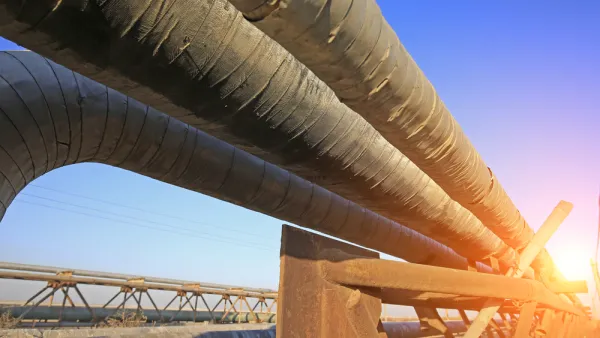The rejection may ultimately doom the $6 billion pipeline to transport Alberta's oil sands crude west through British Columbia for export. Final word is reserved for Prime Minister Stephen Harper, but many say an overturn would be highly unusual.
CBC News reports that the B.C. government has rebuffed the application of Enbridge Inc. to build the Northern Gateway Pipeline (also see Wikipedia description) to carry Alberta bitumen from Edmonton to Kitmat, B.C. that was backed by the government of Alberta Province as well as Canada's Prime Minister Stephen Harper as one means to market the oil sands crude, estimated to be one of the world's largest reserves of oil.
Environment Minister Terry Lake, who appears in an accompanying video, said that the application "fails to address the province's environmental concerns." Earlier, "the province also reiterated the five conditions it says would need to be met in order to approve the pipeline, including top-notch oil spill prevention and response measures." Also see the news release from the B.C. government newsroom explaining the rejection and listing the five conditions that Lake refers to.
Another attached video features Minister James Moore, a member of Prime Minister's Stephen Harper's cabinet, expressing the national government's position of disappointment in the economic consequences of B.C.'s decision but support for the environmental process.
Jason Fekete of The Ottawa Citizen writes, "Seemingly undeterred, the Harper government says it will wait for the National Energy Board-Canadian Environmental Assessment Agency joint review panel’s report — due by the end of the year — before deciding how to proceed".
Ian Austen of The New York Times writes, "While the decision to grant Enbridge a permit ultimately rests with Mr. Harper’s federal government, several environmental groups said that the province’s opposition had probably doomed the pipeline."
In addition to presumably putting more pressure on President Obama to approve the Keystone XL pipeline to transport the oil sands crude to Gulf of Mexico refineries, the decision likely means more business for railroads, which are already transporting record amounts of oil.
Yadullah Hussain of the Financial Post writes on May 28 that "(a)bout 700,000 barrels per day of new rail capacity, roughly the size of Keystone XL pipeline, is expected to come on stream by 2015-16 to help haul Canadian crude to Gulf Coast markets, according to a new report by Canadian Energy Research Institute."
However, rail carries an increased chance of an accidental spill - though less oil may be leaked in each incident. [See E&E: Is rail-bound crude oil a disaster waiting to happen?, subscription required]
Environmental concerns clearly were the key issue for British Columbia in determining whether to give the go-ahead for the controversial pipeline. According to a May 2 CBC News story, a "new report from Simon Fraser University claims there is at least a 90 percent probability of an oil tanker spill if the Enbridge plan for the Northern Gateway pipeline goes ahead."
FULL STORY: B.C. officially opposes Enbridge Northern Gateway pipeline

National Parks Layoffs Will Cause Communities to Lose Billions
Thousands of essential park workers were laid off this week, just before the busy spring break season.

Retro-silient?: America’s First “Eco-burb,” The Woodlands Turns 50
A master-planned community north of Houston offers lessons on green infrastructure and resilient design, but falls short of its founder’s lofty affordability and walkability goals.

Delivering for America Plan Will Downgrade Mail Service in at Least 49.5 Percent of Zip Codes
Republican and Democrat lawmakers criticize the plan for its disproportionate negative impact on rural communities.

Test News Post 1
This is a summary

Test News Headline 46
Test for the image on the front page.

Balancing Bombs and Butterflies: How the National Guard Protects a Rare Species
The National Guard at Fort Indiantown Gap uses GIS technology and land management strategies to balance military training with conservation efforts, ensuring the survival of the rare eastern regal fritillary butterfly.
Urban Design for Planners 1: Software Tools
This six-course series explores essential urban design concepts using open source software and equips planners with the tools they need to participate fully in the urban design process.
Planning for Universal Design
Learn the tools for implementing Universal Design in planning regulations.
EMC Planning Group, Inc.
Planetizen
Planetizen
Mpact (formerly Rail~Volution)
Great Falls Development Authority, Inc.
HUDs Office of Policy Development and Research
NYU Wagner Graduate School of Public Service



























